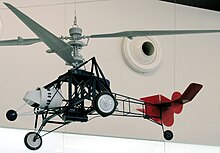Gyroplane Laboratory
The Gyroplane Laboratory is considered to be the world's first practical helicopter .
history
The Frenchman Louis Breguet had been experimenting with rotary wing aircraft since 1907 , but concentrated on fixed wing aircraft again until the late 1920s . From 1929, however, he filed a series of patents dealing with the flight stabilization of rotary wing aircraft.
In 1931 he founded the Syndicat d'Etudes du Gyroplane , together with Rene Dorand as technical director. Their aim was to develop an experimental helicopter called the 'Gyroplane Laboratoire'.
construction
The construction consisted of an open tubular steel frame in which the engine , tank, controls and pilot were housed, supplemented by the tail boom for a plywood tail unit . The landing gear was mounted on wide outriggers, in addition to the rear wheel there was also a small wheel at the front to avoid touching down during landing.
It was driven by a 240 hp Hispano radial engine , which drove the two rotors rotating in opposite directions via a gearbox , the lower one via a hollow shaft . In this construction, known as a coaxial rotor , the torques of the rotors balance each other . The two two-bladed metal rotors were shaped like arrows. The use of cyclical and collective blade adjustment was unique at that time, with which the movement around the pitch (transverse) and roll (longitudinal) axes as well as climb / descent was controlled (see swashplate ).

Flight operations
The Breguet Dorand aircraft was completed in 1933, after ground tests and an accident, the first flight took place on June 26, 1935. Within a short time the pilot Maurice Claisse achieved a number of records:
- December 14, 1935: Circling flight with a diameter of 500 m
- September 26, 1936: Height 158 m
- November 24, 1936: Continuous flight of 1:02:05 hours, circular flight 44 km at 44.7 km / h
- Top speed 120 km / h
The gyroplane laboratory was denied the great attention that the Focke-Wulf Fw 61 helicopter , which was flown a year later, was capable of autorotation and received in specialist circles and the public. Further experiments were carried out until the outbreak of World War II . The only prototype was destroyed in an Allied air raid on Villacoublay airfield in 1943 .
See also
literature
- Engelbert Zaschka : rotary wing aircraft. Gyroscopes and helicopters. CJE Volckmann Nachf. E. Wette, Berlin-Charlottenburg 1936, OCLC 20483709 .
